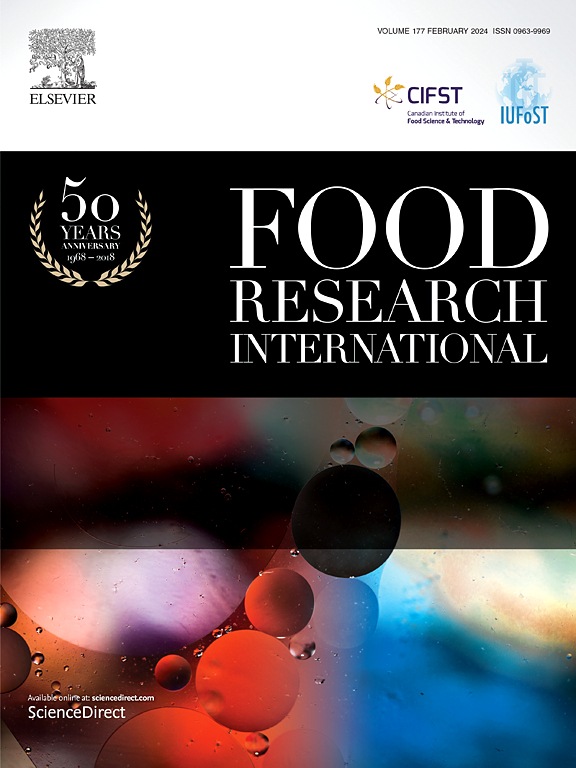Protective effects of microalgal macular pigment on diabetic retinopathy upon blue light irradiation induced oxidative stress, inflammation, and MAPK pathways
IF 8
1区 农林科学
Q1 FOOD SCIENCE & TECHNOLOGY
引用次数: 0
Abstract
Microalgae and their rich nutrient content are increasingly recognized as a sustainable food source. Microalgal macular pigment (MP), composed of zeaxanthin and lutein, is densely concentrated in the retinal macula of eyes and is frequently utilized in eye health maintenance. However, as a sustainable food ingredient, the food safety and functionality of MP need further investigated. There is a lack of scientific studies exploring the protective mechanisms of microalgal MP on diabetic vascular lesions. This study aimed to investigate the effects of MP isolated from Chlorella sp. AT1 in reducing diabetic retinopathy damage in both in vitro and in vivo systems. The microalgal extract is rich MP, with zeaxanthin and lutein in a ratio 1:5. Blue light (BL) irradiation and hyperglycemia increased reactive oxygen species production, and elevated inflammatory factors, including COX-2, NF-κB, and the proteins associated with mitogen activated protein kinase (MAPK) signaling pathway in adult retinal pigment epithelial cells (ARPE-19) and human umbilical vein endothelial cells (HUVEC). However, MP administration significantly mitigated the adverse effects caused by BL exposure and hyperglycemia. In vivo, MP supplementation significantly reduced inflammatory cytokines (TNF-α and IL-6), inflammation-related proteins (iNOS, COX-2, and NF-κB), MAPK pathway proteins, and adhesion factors (ICAM and VCAM) induced by BL irradiation in retinal tissues of diabetic mice. Microalge MP improves inflammatory responses and oxidative stress in diabetic retinopathy under BL irradiation. These findings demonstrate that MP from Chlorella sp. AT1 is a promising sustainable food pigment with protective properties against diabetic vascular disease.

微藻黄斑色素通过蓝光照射诱导氧化应激、炎症和MAPK通路对糖尿病视网膜病变的保护作用
微藻及其丰富的营养成分越来越被认为是一种可持续的食物来源。微藻黄斑色素(Microalgal macular pigment, MP)是一种由玉米黄素和叶黄素组成的物质,在人眼视网膜黄斑中密集分布,常用于眼部保健。然而,作为一种可持续发展的食品原料,其食品安全性和功能性有待进一步研究。微藻MP对糖尿病血管病变的保护机制缺乏科学研究。本研究旨在探讨从小球藻sp. AT1中分离的MP在体外和体内系统中减轻糖尿病视网膜病变损害的作用。微藻提取物含有丰富的MP,玉米黄质和叶黄素的比例为1:5。蓝光(BL)照射和高血糖增加了活性氧的产生,升高了成人视网膜色素上皮细胞(ARPE-19)和人脐静脉内皮细胞(HUVEC)中COX-2、NF-κB和丝裂原活化蛋白激酶(MAPK)信号通路相关蛋白的炎症因子。然而,MP给药显著减轻了BL暴露和高血糖引起的不良反应。在体内,MP可显著降低BL照射诱导的糖尿病小鼠视网膜组织炎症因子(TNF-α和IL-6)、炎症相关蛋白(iNOS、COX-2和NF-κB)、MAPK通路蛋白和粘附因子(ICAM和VCAM)。微藻MP在BL照射下改善糖尿病视网膜病变的炎症反应和氧化应激。这些研究结果表明,小球藻AT1的MP是一种有前景的可持续食用色素,对糖尿病血管疾病具有保护作用。
本文章由计算机程序翻译,如有差异,请以英文原文为准。
求助全文
约1分钟内获得全文
求助全文
来源期刊

Food Research International
工程技术-食品科技
CiteScore
12.50
自引率
7.40%
发文量
1183
审稿时长
79 days
期刊介绍:
Food Research International serves as a rapid dissemination platform for significant and impactful research in food science, technology, engineering, and nutrition. The journal focuses on publishing novel, high-quality, and high-impact review papers, original research papers, and letters to the editors across various disciplines in the science and technology of food. Additionally, it follows a policy of publishing special issues on topical and emergent subjects in food research or related areas. Selected, peer-reviewed papers from scientific meetings, workshops, and conferences on the science, technology, and engineering of foods are also featured in special issues.
 求助内容:
求助内容: 应助结果提醒方式:
应助结果提醒方式:


